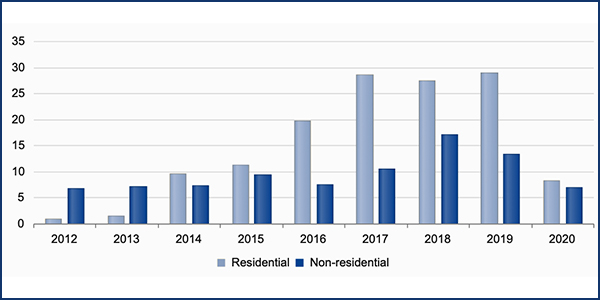New York continues to be a pioneer in expanding access to community solar for low- and moderate-income people, and the New York City Housing Authority (NYCHA) is a powerful agent in that effort, with more clients than the population of most U.S. cities.
NYCHA has a commercial solar program and a residential one, the ACCESSolar program, which aim to install 25 MW of renewable energy on its properties by 2025, generally at less than 40 kW per building, Chris White, an associate with the housing authority’s capital projects/sustainability program, told more than 100 people Thursday in a virtual meeting hosted by Sustainable CUNY at the City University of New York.
The housing authority completed its first round of solicitations last year, with the pandemic greatly disrupting the progress so far in 2020, he said.
“Right now, we’re trying to work through COVID, wrap up some lease agreements and get our first projects constructed. We’re hoping that our first solar panels will be in construction in the next couple of months … and hopeful that we’re going to have our next round of solar opportunities probably around the end of this year,” White said.
The solar program aims to generate revenue, use underutilized spaces, provide job training and green jobs for residents, and reduce energy costs for those who live in NYCHA housing, Section 8 voucher holders and other low- and moderate-income people across the city, White said.
The housing authority serves about 400,000 people in 176,000 apartments and another 200,000 people through its voucher program, the largest numbers of any city in the country, and gets special reduced electricity rates from the New York Power Authority, he said. (See New York City Ramps Up Community Solar.)
Ron Reisman, NYC solar partnership manager for Sustainable CUNY, said the organization has been supporting NYCHA’s program from the beginning three years ago with technical assistance, assessments, proposal evaluations and other services.
Sustainable CUNY developed the New York solar map and portal, which includes a calculator to help residents find the solar potential of their homes or businesses. It includes links to resources on permitting, interconnections, zoning, financing and other topics related to solar and storage, Reisman said. The organization supports both renewable energy development on the university’s campus properties and for New York’s distributed generation framework, he said.
Sharing Benefits
“Supporting the NYCHA initiative is part of our overall mission to expand the deployment of solar in New York City, and energy storage as well, in a way that all New Yorkers can take advantage of energy, environmental and economic benefits,” Reisman said.
The National Renewable Energy Laboratory’s webpage on low- and moderate-income solar policy basics notes that community solar is attractive to many regardless of income, because shading and inadequate roof conditions make solar unsuitable for nearly three-quarters of the residential rooftops in the U.S.
The lab says several jurisdictions have begun exploring community solar to expand solar access to low- and moderate-income communities, and mentions New York as one of four states — California, Colorado and Oregon are the others — that have enacted low-income carve-outs as part of their community solar policies.
The New York Public Service Commission’s 2015 order establishing net metering gave special consideration to projects that promised 20% participation by low-income people (15-E-0082).
“We’re very excited about the work we’re doing installing solar at the [NYCHA’s] Carver Houses,” said Charles Callaway of WE ACT for Environmental Justice, who also has a seat on the state’s 22-member Climate Action Council. “If we weren’t in this pandemic of COVID-19, we’d probably be in the buildings.”
His organization is looking to recruit a couple buildings in East Harlem into the solar program and working to get residents the cost estimates needed to move forward on installing solar panels.
“Getting people the information they need to sign up for community solar is very important,” Callaway said. “We’ve tried a couple of strategies around just doing street outreach.”
Callaway reported some low-income people being fearful of innovative clean energy programs after having been “scammed” by unethical energy service companies, a practice that the PSC has cracked down on repeatedly in recent years. (See NYPSC Reins in ESCOs, Expands Community DG.)
The mayor’s office works with Sustainable CUNY and the NYC Economic Development Corporation to expand access to the benefits of solar energy and other forms of renewable energy. Programs include Solarize NYC — for community group purchasing — and a related program called Shared Solar NYC.
Juan Parra, community solar program manager with Solar One, an environmental education nonprofit in the city, said his organization is involved in two active projects now: a 685-kW project in Sunset Park, on the roof of the Brooklyn Army Terminal, and NYCHA’s ACCESSolar.
“We’re implementing workforce training opportunities, so we’re not just training folks in solar installation skills, but actually making commitments with the installer to hire them as part of the solar installations for these projects,” Parra said. “We’re excited that training is going to start next week.”
Daphany Sanchez of Kinetic Communities Consulting worked with NYCHA on the solar project and said the housing authority is working in Harlem to learn how to scale community solar for small businesses and local nonprofits.
“Community-based organizations have done outreach in the past, so when we talk about community solar outreach, the concerns are around how do we ensure these are truly low- and moderate-income people, how do we capture that information, when in reality such organizations” have secured the same personal information for housing, health and education, Sanchez said. “It is not new.”





